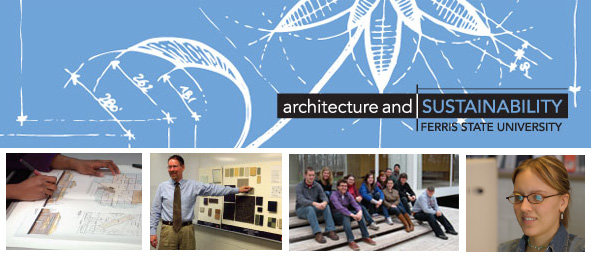School of Built Environment
605 S. Warren
GRN 227
Big Rapids MI 49307
(231) 591-3773

Sustainability is transforming the architectural profession. The term has become ubiquitous; not only is it associated with design and construction of “green” buildings, but it is also attached to economic development, business practices, and more. “Sustainability” is a concept that looks critically at humanity’s past relationship with the environment, provides goals for the present and creates potential for the future. With the convergence of events such as soaring population growth, climate change and diminishing resources, the practice of sustainability is essential as we face these unprecedented challenges.
With the growing understanding of the negative impact buildings have on the environment architects, engineers, contractors and manufacturers have been aggressively seeking new approaches and techniques to make buildings more energy efficient; but these approaches are to a great extent additive instead of organic to the building process.
It is becoming increasingly apparent that a more organic approach to architectural education is needed to train future generations of professionals in design and construction methodologies rooted in sustainable principles. Ferris’ Bachelor of Science in Architecture and Sustainability is shaped in such an organic context in which education in building technology and design is conceived in a social and cultural context of community planning that values responsible approaches to resource management and the environment. This educational framework provides a comprehensive understanding of issues on a social and global scale, highlighting humanity’s role in shaping the community and environment.
The primary goal of the BS in Architecture and Sustainability is to teach students to embrace sustainability and community planning principles so that in the future buildings will not be perceived merely as objects unrelated to their setting, but components in a complex environmental pattern of natural features, constructed elements, and the people who interact with them.
![]() Download a pdf version of the Architecture & Sustainability Brochure
Download a pdf version of the Architecture & Sustainability Brochure
Architecture and Sustainability Students Create 2013 ArtPrize Piece